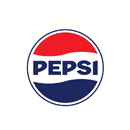
Pepsi
Purchase, Harrison, New York, U.S.Founding:
Pepsi was created in 1893 by Caleb Bradham, a pharmacist from North Carolina, initially named "Brad's Drink." He concocted it as a digestive aid and energy booster by blending sugar, water, caramel, lemon oil, nutmeg, and other natural additives.Rebranding: In 1898, Bradham renamed it Pepsi-Cola, deriving the name from the word "dyspepsia" and the kola nuts used in the recipe, emphasizing its aid in digestion and energy.
Milestones:
1920s-1940s: Pepsi-Cola's success grew during the 1920s through aggressive marketing, price cuts, and a larger bottle for the same price as Coca-Cola.
1950s-1960s: Expansion globally and innovative campaigns like the "Pepsi Generation" marked this era.
1970s-1990s: Pepsi continued its marketing innovations, including the famous "Pepsi Challenge" and significant sponsorships in sports and entertainment.
2000s-Present: Expansion into various markets worldwide, continual product diversification, and partnerships.
Evolution:
Product Diversification: Pepsi expanded its product line beyond its flagship cola, introducing diet variations, flavored sodas, and non-carbonated beverages like Aquafina and Gatorade.
Acquisitions: Acquiring Frito-Lay in 1965 further diversified PepsiCo, creating a vast portfolio of snacks and beverages.
Cultural Context:
Pop Culture Influence: Pepsi has often aligned itself with popular culture, leveraging celebrity endorsements and innovative advertising campaigns to resonate with different generations.
Social Initiatives: Engaged in various social initiatives and campaigns addressing environmental sustainability, health, and social responsibility.
Positioning & Brand Values:
Youthful & Energetic: Positioned itself as a brand for the young and energetic, emphasizing vibrancy and modernity.
Values: Emphasizes on innovation, diversity, and social responsibility in its brand narrative.
Product Design:
Packaging & Design: Pepsi has undergone multiple redesigns in its packaging, often emphasizing modernity, vibrancy, and freshness.
Visual Evolution:
Logo & Branding: The Pepsi logo has evolved from its original script to the iconic red, white, and blue circle we know today.
Successes and Challenges:
Successes: Continuous innovation, effective marketing campaigns, and diversification of product lines have driven growth.
Challenges: Intense competition with Coca-Cola, changing consumer preferences, and the need to adapt to health-conscious trends.
Controversies:
Advertising Issues: Some ad campaigns faced criticism, like the Kendall Jenner ad that was perceived as tone-deaf.
Product Range:
Sodas: Pepsi, Diet Pepsi, Pepsi Max
Non-carbonated beverages: Aquafina, Gatorade, Tropicana, etc.
Snacks: Frito-Lay brands like Lay's, Doritos, Cheetos, etc.
Competitors in Different Segments:
Soda Segment: Competes primarily with Coca-Cola.
Snacks Segment: Competes with various brands like Kraft Heinz, Mondelez International, etc.
Revenue Streams & Financials:
Diversified Revenue: PepsiCo generates revenue from a broad portfolio of snacks and beverages.
Financials: Consistently strong financial performance, with revenue streams coming from various global markets.
- Other Brands
- Apple
- Microsoft
- Amazon
- Google
- Samsung
- Toyota
- Mercedes-Benz
- Coca-Cola
- Nike
- BMW
- McDonald’s
- Tesla
- Disney
- Louis Vuitton
- Cisco
- Instagram
- Adobe
- IBM
- Oracle
- SAP
- Facebook
- Chanel
- Hermes Paris
- Intel
- YouTube
- JP Morgan
- Honda
- American Express
- Ikea
- Accenture
- Allianz
- Hyundai
- UPS
- Gucci
- Pepsi
- Sony
- Visa
- Salesforce
- Netflix
- PayPal
- Mastercard
- Adidas
- ZARA
- AXA
- Audi
- airbnb
- Porsche
- Starbucks
- GE
- Volkswagen
- Ford
- Nescafe
- Siemens
- Goldman Sachs
- Pampers